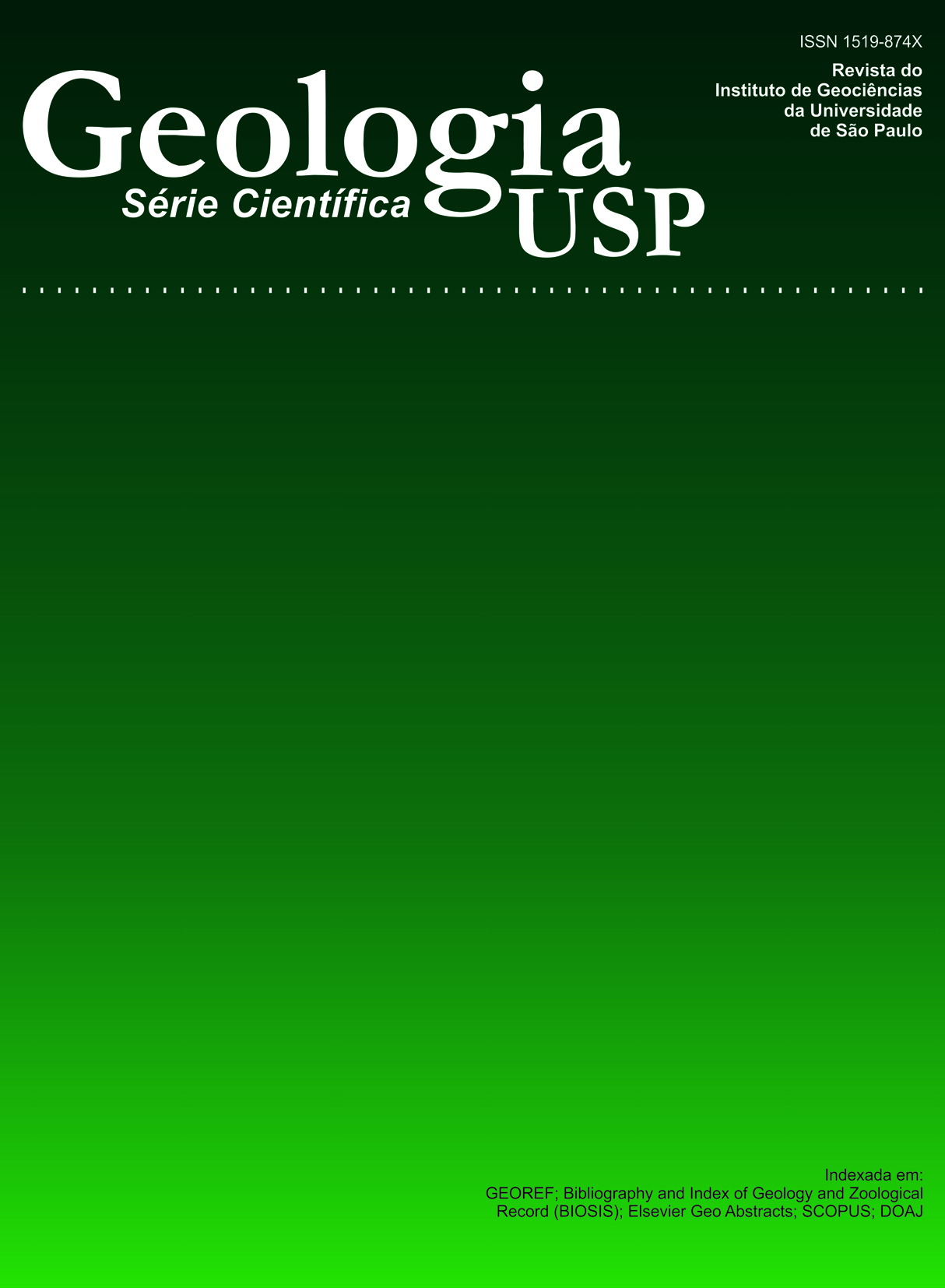Tourmaline and rutile as indicators of a magmatic-hydrothermal origin for tourmalinite layers in the São José do Barreiro area, NE Ribeira Belt, southern Brazil
DOI:
https://doi.org/10.5327/Z1519-874X2010000300007Keywords:
Tourmalinites, Rutile, São José do Barreiro Granite, REE in tourmalineAbstract
Tourmalines from tourmaline-rich layers intercalated with schists of the Rio Una Unit of the Embu Complex and from coarse-grained tourmalinite layers associated with quartzite from São José do Barreiro and Formoso (Central Ribeira Belt, São Paulo State, Brazil) were analyzed for major, trace- and rare-earth elements and boron stable isotopes. Two main phases of tourmaline formation were identified by mineral chemistry. The tourmalines from the schist-hosted tourmaline layers are characterized by relatively low MgO (from 4.7 to 6.5%), Na2O (1.5 to 2.1%) and CaO (from 0.2 to 1.1%) contents and high Al2O3 (from 32 to 35%) and FeO (from 6.7 to 9.0%) contents, and also by two (REE)CN patterns, one represented by (La/Yb)CN from 2.7 to 4.3 and positive Eu anomalies, and the other by (La/Yb)CN from 0.2 to 0.3 and practically no Eu anomaly. The variations in major-element contents reflect the composition of the rock being metamorphosed and in which tourmaline is crystallizing, whereas the (REE)CN patterns indicate the evolution of the metamorphic fluid in face of changing metamorphic conditions. The tourmaline of the tourmalinite layers intercalated in quartzite is characterized by relatively high Al2O3 (from 32.3 to 33.92%), FeO (from 6.54 to 7.3%) and Na2O (from 1.8 to 2.1%) contents and very low total REE (3.5 ppm) contents, in particular of HREE. The (REE)CN pattern for this tourmaline is characterized by a positive Eu anomaly, indicating a high fluid/rock ratio. The δ11B values for this tourmaline fall in the -12.3 and -13.9 interval. On the other hand, the tourmaline of a massive tourmalinite also associated with quartzite has the highest MgO (from 7.3 to 9.7%), CaO (from 0.8 to 2.5%), F, Th, U, Hf, Zr, Y, Sr and total REE (305 ppm) contents and the lowest Al2O3 (from 28.6 to 31.8%) and FeO (from 5.4 to 8.3%) contents, when compared to the other tourmalines analyzed. Differing from all other (REE)CN patterns, the one that characterizes this tourmaline is LREE-enriched [(La/Yb)CN = 5.8] and shows a slightly negative Eu anomaly. Negative δ11B values in the -13.9 and -15.8 interval indicate, as the other interval, filiation with S-type granite magmatism-hydrothermalism. The massive tourmalinite also contains zircon, scheelite, and monazite as accessory minerals and relatively abundant (green and red) rutile. The green rutile is enriched in Nb, Al, Fe and Sn when compared to the red rutile, which is Cr rich. The differences in composition observed in the tourmaline and rutile of the massive tourmalinite indicate the involvement of magmatic-hydrothermal fluids with metamorphic fluids from which tourmaline and other minerals crystallized. The syn-collisional, S-type São José do Barreiro Granite is the possible source for the magmatic-hydrothermal fluids.Downloads
Download data is not yet available.
Downloads
Published
2010-10-01
Issue
Section
Articles
License
Authors who publish in this journal shall comply with the following terms:
- Authors keep their copyright and grant to Geologia USP: Série Científica the right of first publication, with the paper under the Creative Commons BY-NC-SA license (summary of the license: https://creativecommons.org/licenses/by-nc-sa/4.0 | full text of the license: https://creativecommons.org/licenses/by-nc-sa/4.0/legalcode) that allows the non-commercial sharing of the paper and granting the proper copyrights of the first publication in this journal.
- Authors are authorized to take additional contracts separately, for non-exclusive distribution of the version of the paper published in this journal (publish in institutional repository or as a book chapter), granting the proper copyrights of first publication in this journal.
- Authors are allowed and encouraged to publish and distribute their paper online (in institutional repositories or their personal page) at any point before or during the editorial process, since this can generate productive changes as well as increase the impact and citation of the published paper (See The effect of Open Access and downloads on citation impact).
How to Cite
Garda, G. M., Beljavskis, P., D'Agostino, L. Z., & Wiedenbeck, M. (2010). Tourmaline and rutile as indicators of a magmatic-hydrothermal origin for tourmalinite layers in the São José do Barreiro area, NE Ribeira Belt, southern Brazil . Geologia USP. Série Científica, 10(3), 97-117. https://doi.org/10.5327/Z1519-874X2010000300007





